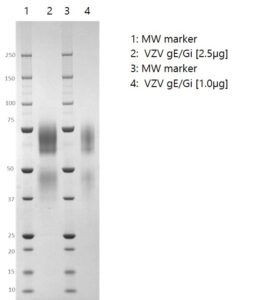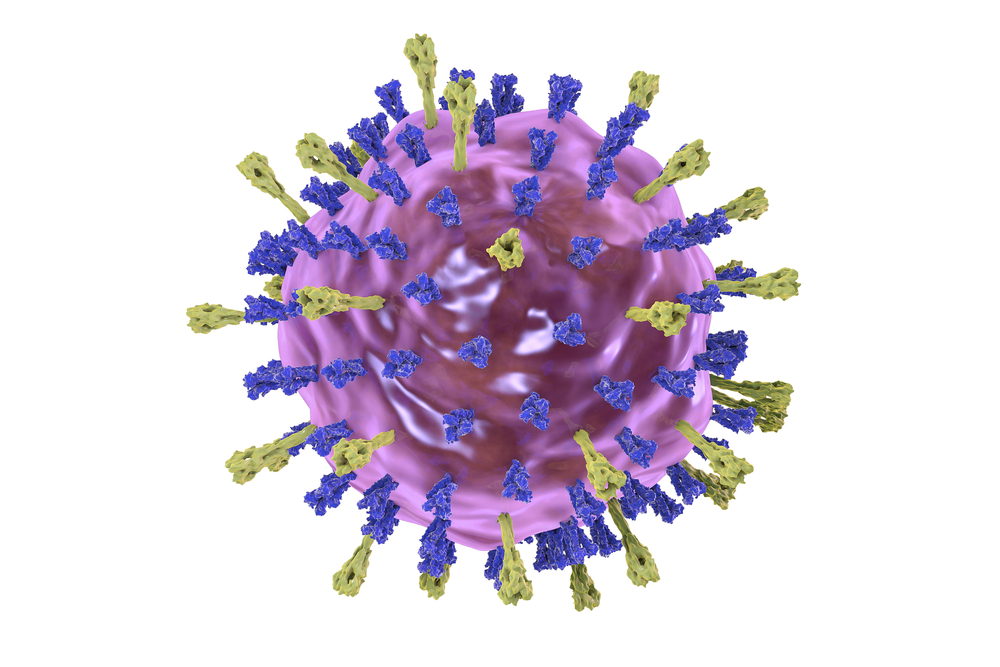
SDS-PAGE: Coomassie-stained SDS-PAGE showing purified VZV gE/gI heterodimeric protein.
Varicella-Zoster Virus Heterodimer gE/gI (HEK293), His-tag
Price range: $512.90 through $1,801.46 excl. VAT
Varicella Zoster virus glycoprotein E (gE) glycoprotein I (gI) heterodimer. The heterodimer is labelled with a C-terminal His-tag on gE only. The protein complex was produced in HEK293 cells and purified from culture supernatant by immobilised metal affinity chromatography.
VARICELLA-ZOSTER VIRUS HETERODIMER GE/GI (HEK293), HIS-TAG
Varicella Zoster virus glycoprotein E (gE) glycoprotein I (gI) heterodimer. The heterodimer is labelled with a C-terminal His-tag on gE only. The protein complex was produced in HEK293 cells and purified from culture supernatant by immobilised metal affinity chromatography.
PRODUCT DETAILS – VARICELLA-ZOSTER VIRUS HETERODIMER GE/GI (HEK293), HIS-TAG
- Varicella Zoster virus glycoprotein E (gE) glycoprotein I (gI) heterodimer, Accession number: Q9J3M8.1 (gE), QCY53727.1 (gI).
- The heterodimer is labelled with a C-terminal His-tag on gE only.
- The protein complex was produced in HEK293 cells and purified from culture supernatant by immobilised metal affinity chromatography.
BACKGROUND
Varicella-zoster virus (VZV) is a alphaherpesvirus which causes chicken pox (varicella) and shingles (zoster) (Gershon et al., 2015; Gabutti et al., 2016). The VZV 125-kb genome is the smallest of the alphaherpesviruses and is comprised of a unique long (UL) and unique short (US) region flanked by internal and terminal repeats. As with other herpesviruses, VZV requires glycoproteins on the virion surface for cell entry and cell-to-cell spread. Nine glycoproteins are encoded by the VZV genome. Two glycoproteins critical to VZV, gE and gI, are encoded by open reading frame 68 (ORF68) and ORF67, respectively, located in the US region of the genome. These two VZV glycoproteins (gE and gI) form a heterodimer that mediates efficient cell-to-cell spread. Deletion of ORF68 (gE) is lethal to VZV. Deletion of ORF67 (gI) results in a virus with a small-plaque phenotype in vitro, which cannot be recovered from inoculated human skin xenografts (Mallory et al., 1997; Mo et al., 2002). The noncovalent heterodimer that forms between gE and gI can be disrupted by the deletion of the first cysteine-rich region in gE, severely impairing replication in human skin tissue.
REFERENCES
- Gabutti G, Franchi M, Maniscalco L, Stefanati A. Varicella-zoster virus: pathogenesis, incidence patterns and vaccination programs. Minerva Pediatr. 2016 Jun;68(3):213-25.
- Gershon AA, Breuer J, Cohen JI, Cohrs RJ, Gershon MD, Gilden D, Grose C, Hambleton S, Kennedy PG, Oxman MN, Seward JF, Yamanishi K. Varicella zoster virus infection. Nat Rev Dis Primers. 2015 Jul 2;1:15016.
- Mallory S, Sommer M, Arvin AM. Mutational analysis of the role of glycoprotein I in varicella-zoster virus replication and its effects on glycoprotein E conformation and trafficking. J Virol. 1997 Nov;71(11):8279-88.
- Mo C, Lee J, Sommer M, Grose C, Arvin AM. The requirement of varicella zoster virus glycoprotein E (gE) for viral replication and effects of glycoprotein I on gE in melanoma cells. Virology. 2002 Dec 20;304(2):176-86.

